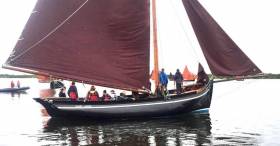Displaying items by tag: Crinnui na mBad
Kinvara Rises Above the Weather for Fortieth Cruinniu na mBad
When the late Tony Moylan cajoled the notion of Cruinnui na mBad at Kinvara into being in 1979, times were different writes W M Nixon. The idea was to celebrate the Gathering of the Boats in the old days, when the traditional boats of Connemara on the great inlet’s northwest shore sailed up Galway Bay as Autumn approached well laden with turf, one of the few commodities in which their area was naturally richer than the prosperous region around the southeast corner of the handsome bay.
This year, they celebrated the memory of Tony Moylan in the best possible way, by making Cruinniu na mBad bigger and better and more varied than ever for its Fortieth Anniversary. And though the weather was less than co-operative with a seemingly endless deluge on Saturday, for the big day – Sunday – conditions gradually relented, and Kinvara came colourfully to life in evening sunshine after the ancient craft with their black or tanned sails had experienced good racing.
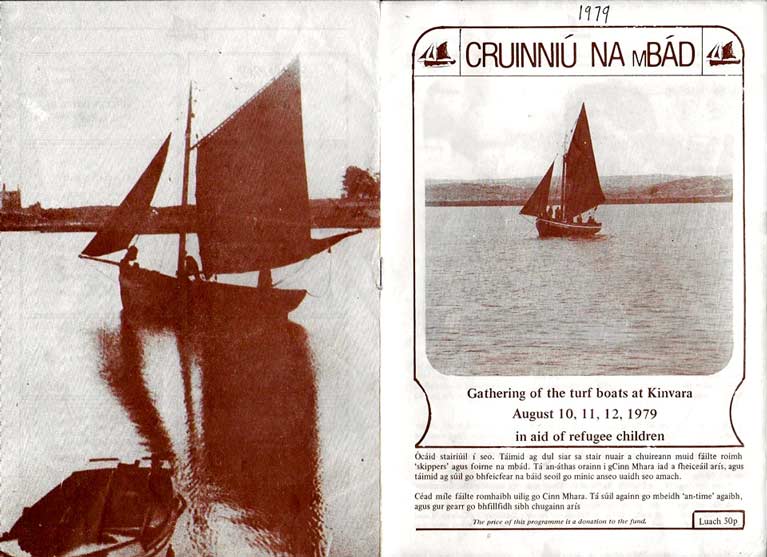 Simpler times. Front and back cover of the booklet for the first Cruinniu na mBad in 1979
Simpler times. Front and back cover of the booklet for the first Cruinniu na mBad in 1979
Cruinniu na mBad is all about the dynamic interaction between sea and land along Ireland’s Atlantic seaboard, and though the conditions on Saturday saw the emphasis inevitably falling on the landward part of the equation – and the indoor aspect of the landward part at that – there were enough musicians and singers and declaimers of poetry and ancient tales in town to keep the show in the road, even if rain came down extremely heavily with impartial force on both the largest thatched roof in all Ireland – it shelters the Merriman Hotel – and roofs of more prosaic style.
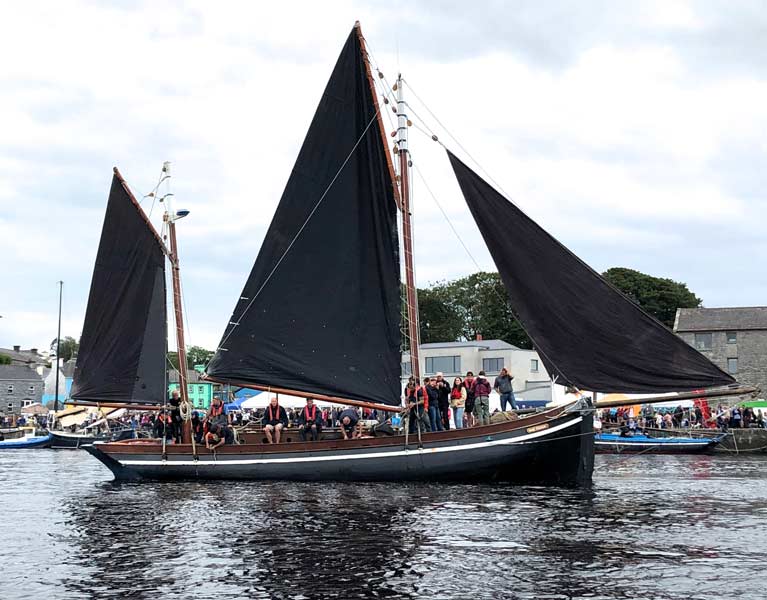 A Committee Boat with a difference – Dr Mick Brogan’s Mac Duach is one of the largest Galway hookers ever built, and though originally a cutter, she has continued her extensive cruising in recent years under ketch rig. Photo: Pierce Purcell
A Committee Boat with a difference – Dr Mick Brogan’s Mac Duach is one of the largest Galway hookers ever built, and though originally a cutter, she has continued her extensive cruising in recent years under ketch rig. Photo: Pierce Purcell
Back in 1979, the digging of turf by hand in the bogs of south Connemara, and then sailing it all the way up the bay, must have seemed one of the most natural and ecologically-sound re-livings of the past you could possibly imagine. But in this hyper-sensitive era, even the burning of humble turf is under scrutiny as a possible menace to our fragile planet, as is the digging of bogs. In the case of Kinvara, it’s something which poses a quandary, for the turf is cut by hand, piled to dry by hand, then moved to be laden by hand onto boats which are sailed by hand – and every bit of it is very hard work if you want to see it as work in the first place.
It’s shared work in a continuum from the land to the sea and back to the land again, and it is nature’s abundant wind which provides the motive power. So anyone who would wish to discourage the Kinvara experience from the turf-burning point of view needs to get a sense of proportion – after all, the Festival itself was promoting the plastic-free ideal as one of its main themes. But in any case we’re talking of turf amounts which are symbolic rather than of significant size, and we’re thinking that the meaning which this annual combination of actions and activities afloat and ashore gives to those involved is something very deep-rooted indeed, an eloquent expression of community.
 Naomh Cailin, skippered by Pat Folan, comes to the mark in style. She finished second overall in the Bad Mhora class. Photo: Pierce Purcell
Naomh Cailin, skippered by Pat Folan, comes to the mark in style. She finished second overall in the Bad Mhora class. Photo: Pierce Purcell
Certainly it’s something which folk from elsewhere wish to share, bringing in crews and boats of other types from places beyond the sea, interesting boats like the comely Sally O’Keeffe from Querrin on the shores of the Shannon Estuary, a very attractive 25ft community-built cutter which is an authentic re-creation of the sailing working boats which used to ply the waters of the mighty Shannon Estuary.
 The Sally OKeeffee had sailed round to Kinvara from the Shannon Estuary – on board are Fintan Ryan, Steve Morris and Dixie Collins. Photo: Pierce Purcell
The Sally OKeeffee had sailed round to Kinvara from the Shannon Estuary – on board are Fintan Ryan, Steve Morris and Dixie Collins. Photo: Pierce Purcell Galway Hooker Association Honorary Secretary Padraic de Bhaldraith at the helm of his gaff cutter Mrs Mouse, hewn from traditional glassfibre…..Photo: Pierce Purcell
Galway Hooker Association Honorary Secretary Padraic de Bhaldraith at the helm of his gaff cutter Mrs Mouse, hewn from traditional glassfibre…..Photo: Pierce Purcell
Also there was the hefty ketch Celtic Mist, research vessel of the Irish Whale & Dolphin Group whose CEO Simon Berrow was on hand with a group of fellow-enthusiasts to spread the message and answer queries while SAR helicopters buzzed overhead and the Galway Lifeboat – crew and boat alike – were keenly represented for the two main days, and talked afterwards of the marvellous sense of community in Kinvara.
 The Irish Whale & Dolphin Group’s much-travelled research vessel Celtic Mist was in Kinvara to spread the word
The Irish Whale & Dolphin Group’s much-travelled research vessel Celtic Mist was in Kinvara to spread the word Marieke Huysman’s music-centre Freedom 40 ketch is a Gary Hoyt design. Her piano is set up on the after deck. Photo: Pierce Purcell
Marieke Huysman’s music-centre Freedom 40 ketch is a Gary Hoyt design. Her piano is set up on the after deck. Photo: Pierce Purcell
Meanwhile, a completely different yet equally appropriate aspect of seafaring was being provided by sea-musician Marieke Huysmans of PianOcean, whose piano was set up on the deck of her Freedom 40 type ketch, which aptly is called Freedom
But inevitably and rightly the attention is mainly on the hookers, which vary in sizes between at least four classes – some would say six – while no two boats are identical, for individuality is the default setting of the west. Presiding over all this was the empress of them all, Organising Committee Chairman Dr Mick Brogan”s giant hooker Mac Duach, which was originally built as a cutter, but at that size her main boom was such a widow-maker that in due course the good doctor made her a more manageable ketch, under which rig she has continued a busy programme of ocean and coastal voyaging and attending western maritime festivals.
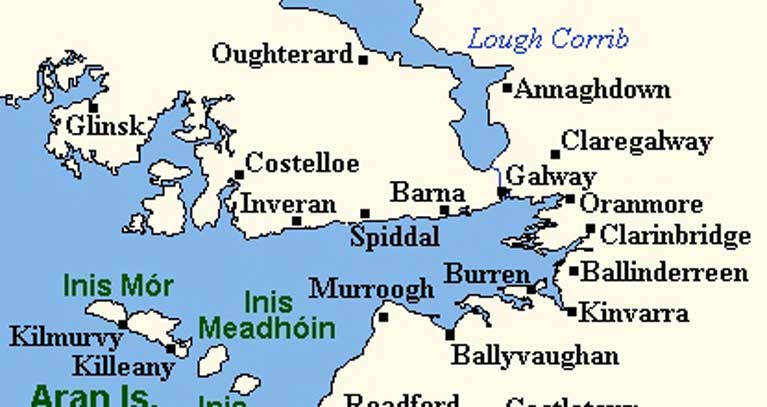 A time-honoured sea trail. The turf is traditionally sailed up Galway Bay from small harbours in the rugged Glinsk region (top left) to the relatively gentle and very sheltered harbour of Kinvara (bottom right)
A time-honoured sea trail. The turf is traditionally sailed up Galway Bay from small harbours in the rugged Glinsk region (top left) to the relatively gentle and very sheltered harbour of Kinvara (bottom right)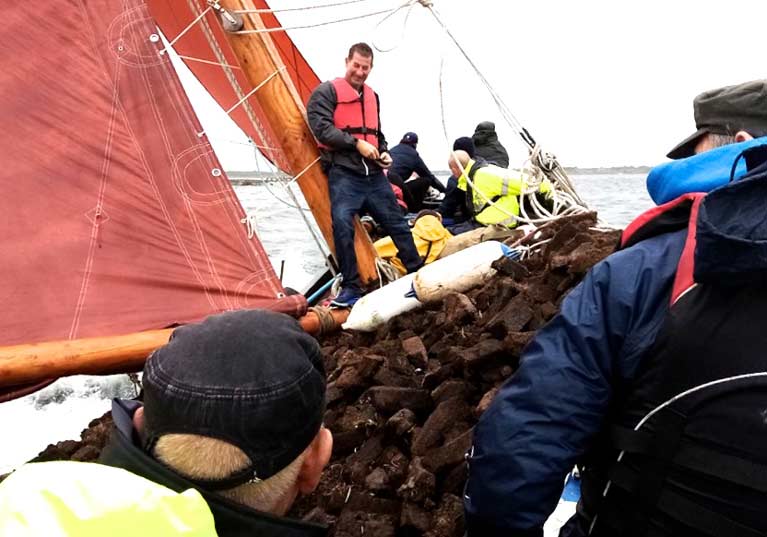 Very little room for the crew……An Mhaighdean Mhara is generously laden with turf as she makes speed from Connemara towards Kinvara. Photo: Iris Aniar
Very little room for the crew……An Mhaighdean Mhara is generously laden with turf as she makes speed from Connemara towards Kinvara. Photo: Iris Aniar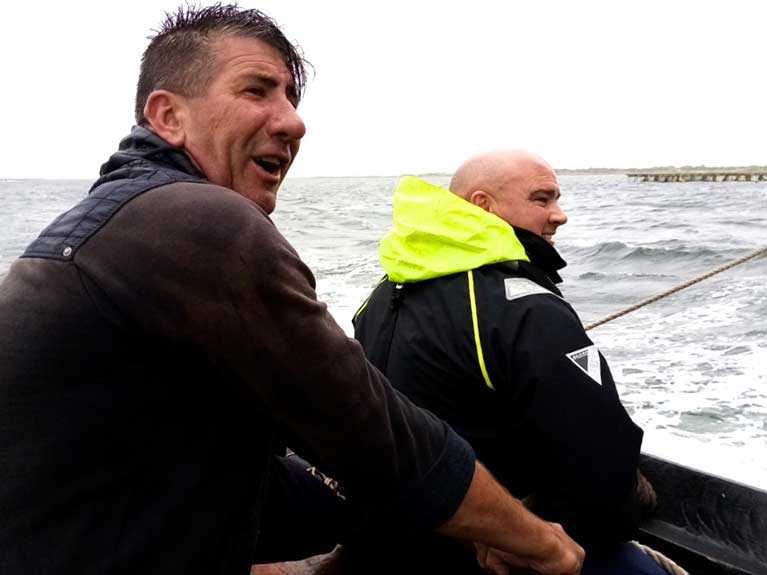 Hard-driving men – Jimmy Mac Donncha and Colm Ciaran O Flatharta getting the knots out of the turf-laden Mhaighdean Mhara as they approach Kinvara. Photo: Iris Aniar
Hard-driving men – Jimmy Mac Donncha and Colm Ciaran O Flatharta getting the knots out of the turf-laden Mhaighdean Mhara as they approach Kinvara. Photo: Iris Aniar Safely in – An Mhaighdean Mhara has glided safely in to Kinvara pier, and the unloading of the cargo is under way. Photo: Iris Aniar
Safely in – An Mhaighdean Mhara has glided safely in to Kinvara pier, and the unloading of the cargo is under way. Photo: Iris Aniar
The main player in the symbolic bringing in of the turf was the mighty An Mhaighdean Mhara, built by McDonagh of Callahaigue in Connemara a very long time ago, re-built or partially re-built now and again since - as is the way of the west - and sailed with considerable style to Kinvara by Jimmy Mac Donncha aided by Colm Ciaran O Flatharta, and laden with such a pile of turf in what is usually the cockpit that the rest of the crew were finding what comfort they could on the foredeck as An Mhaighden Mhara shaped her course into Kinvara’s long natural harbour, gliding alongside the quay to begin the long and sweaty job of discharging the cargo by hand.
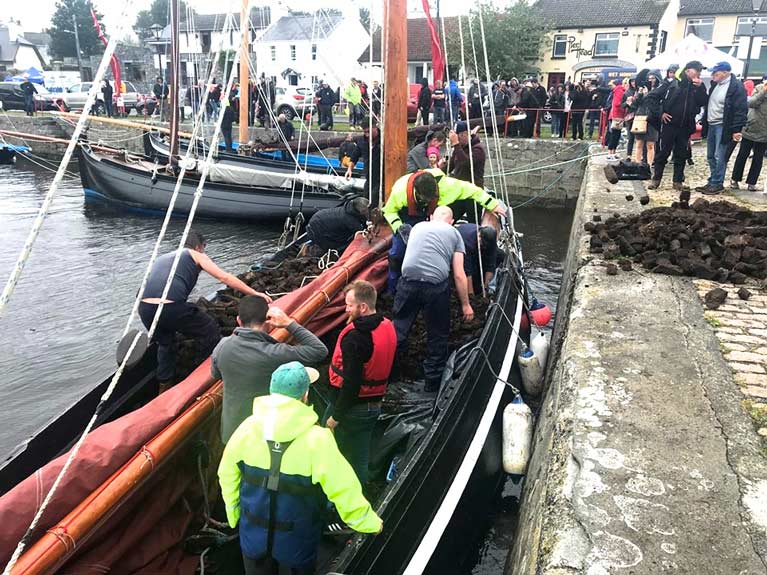 Not a job for the faint-hearted – all of An Mhaighdean Mhara’s cargo was to be unloaded by hand……..Photo: Iris Aniar
Not a job for the faint-hearted – all of An Mhaighdean Mhara’s cargo was to be unloaded by hand……..Photo: Iris Aniar
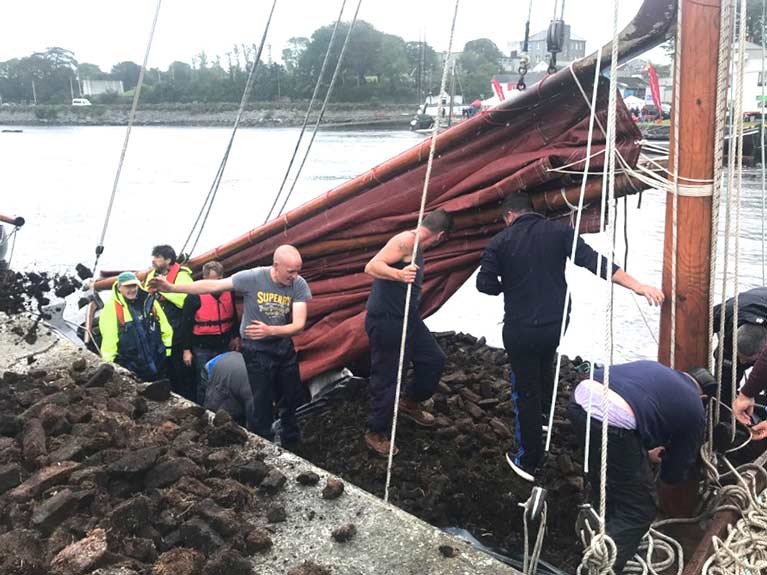 The rhythm of unloading is gathering speed and co-ordination. Photo: Iris Aniar
The rhythm of unloading is gathering speed and co-ordination. Photo: Iris Aniar
With the many and varied rituals completed or at least set in train, Sunday brought the racing, as hard fought as ever. As anyone who has ever tried to report on Galway hooker racing - whether at Kinvara or one of the traditional events in Connemara itself – there will be as many different versions of what happened during the race as there are people involved, for at times it cannot even be agreed within crews as to what happened or didn’t. Yet when they’re eventually published, there’s a finality about results which sets the story to rest, and we can do no more than publish them as they were – in due course – supplied to us.
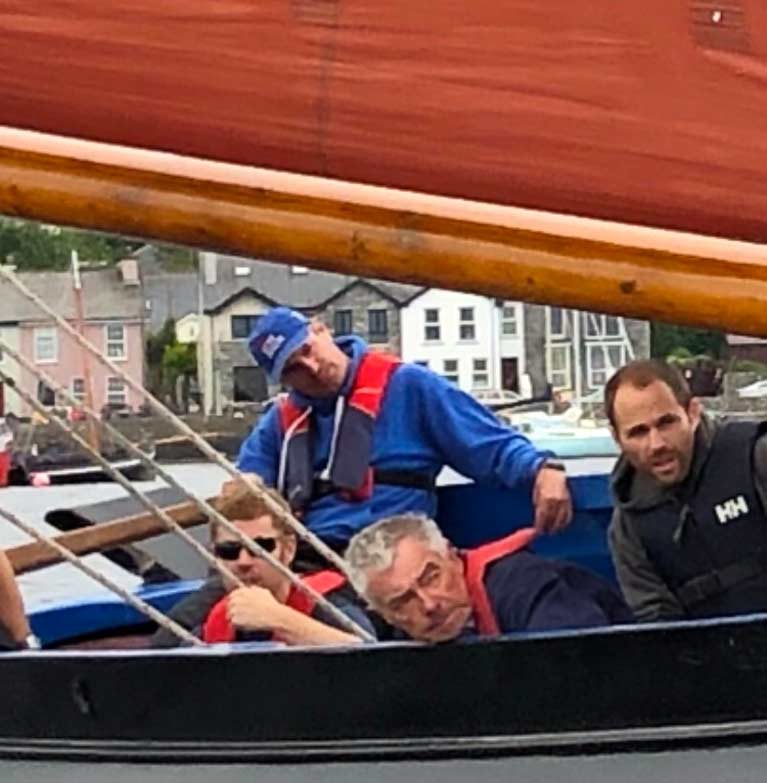 Pre-start tension. Defending champion in the Bad Mhora class An Tonai shaping in for the line, with Captain-General Mairtin O’Brian sizing up the situation with his chin on the rail, while Skipper Ronan O'Brien looks to the helming. Their defence of the title was successful. Photo: Pierce Purcell
Pre-start tension. Defending champion in the Bad Mhora class An Tonai shaping in for the line, with Captain-General Mairtin O’Brian sizing up the situation with his chin on the rail, while Skipper Ronan O'Brien looks to the helming. Their defence of the title was successful. Photo: Pierce Purcell
Cruinniu na mBad 2019 Results:
Bad Mhora: 1st Tonai, skippered by Ronan O’Brien; 2nd Cailin, sk. Pat Folan; 3rd An Mhaghdean Mhara, sk. Jimmy Mac Donncha
Leath-Bhaid: 1st Norah, sk. Sean Mac Donncha; 2nd Colmcille, sk. Mairtin Thornton; 3rd Antain, sk. Joe Reaney
Gleiteog Mor: 1st Catherine, sk. Paraic Barrett; 2nd Ciarain, sk. John Flaherty; 3rd An Bhantra, sk. Daragh O Tuairisc
Gleiteog Beag: 1st Erin’s Hope, sk. Pat Folan; 2nd Sianach, sk. Ciaran Mac Donncha, 3rd Nora Bheag, sk. Coilin Og Hernon.
The sport over, the sun appeared - and Kinvara partied.
 Finally, a bit of evening sunshine to round out the day. Photo: Pierce Purcell
Finally, a bit of evening sunshine to round out the day. Photo: Pierce Purcell
Colie Hernon and his family were setting the competitive pace over the weekend at the Crinniu na mBad in Kinvara, with the man himself winning the leath bad race with the 2012-built Croi an Cladaig, while his son Colie og Hernon was winner in the gleotogs with Nora Bheag writes W M Nixon.
The very handsome Croi an Cladaig featured here last week when we were previewing the annual festival, which in its modern form was founded by Tony Moylan in 1979 as a celebration of the western maritime and folk traditions.
 Croi an Cladaigh sailing in the kind of weather everyone had hoped for at the weekend, but it didn’t arrive. The superb sails were made in the west by Dara Baily.
Croi an Cladaigh sailing in the kind of weather everyone had hoped for at the weekend, but it didn’t arrive. The superb sails were made in the west by Dara Baily.
The sunlit image of Croi an Cladaig was so cheering that we were moved to put the most favourable possible spin on the weather predictions. That inspiring mainsail, by the way, was made in Connemara by Dara Bailey. But as our photos from the Pierces Purcell, father and son, clearly indicate, far from a brisk and sunny westerly, a huge crowd and a large fleet had to make do with rain and a fitful sou’east breeze.
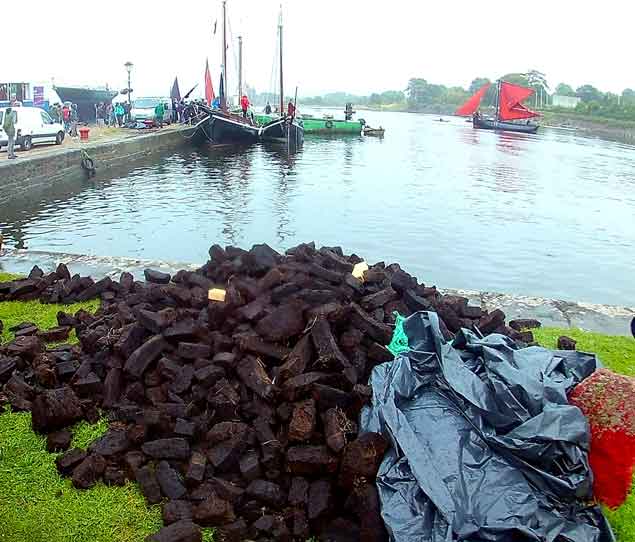 Part of the tradition is the delivery by hookers of the Connemara turf
Part of the tradition is the delivery by hookers of the Connemara turf
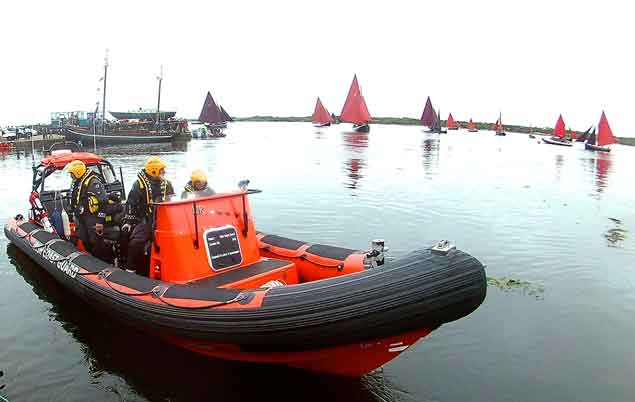 The Coastguard Service plays a key role in Galway Bay, and the local division were welcome guests at Kinvara
The Coastguard Service plays a key role in Galway Bay, and the local division were welcome guests at Kinvara
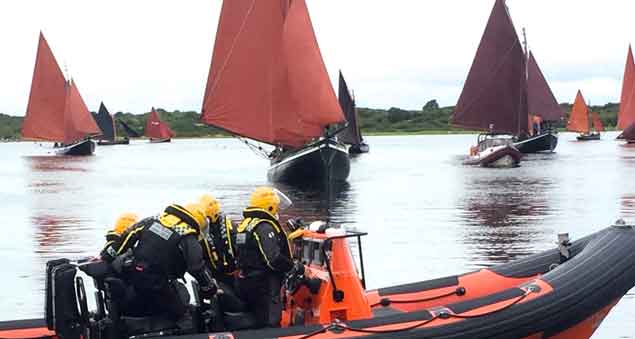 ….and they were able to get the best view of a slow-moving but fascinating race Yet the boats were so interesting and the onshore entertainments and food & drink experiences so many and varied that some who were there claim they didn’t notice any rain at all. Under the benign direction of Dr Michael Brogan it all went swimmingly, deliberately so in the case of those who took part in the time-honoured cross-harbour swim, and preferably not swimming at all for those who were in the in the seaweed boat race – don’t ask, the photo says it all.
….and they were able to get the best view of a slow-moving but fascinating race Yet the boats were so interesting and the onshore entertainments and food & drink experiences so many and varied that some who were there claim they didn’t notice any rain at all. Under the benign direction of Dr Michael Brogan it all went swimmingly, deliberately so in the case of those who took part in the time-honoured cross-harbour swim, and preferably not swimming at all for those who were in the in the seaweed boat race – don’t ask, the photo says it all.
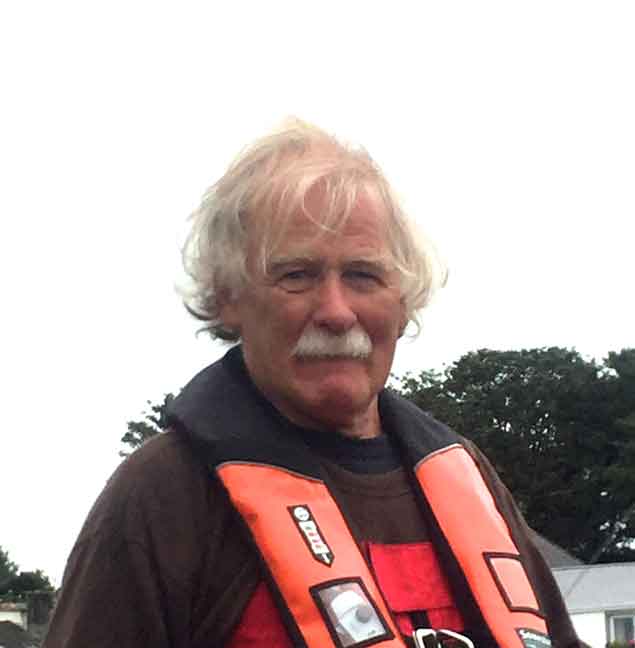 Dr Michael Brogan was the benign director of events
Dr Michael Brogan was the benign director of events
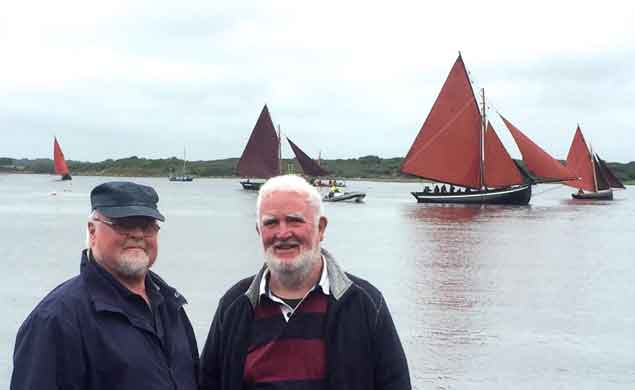 Men of the west – Pierce Purcell of Galway and Arctic voyager Jarlath Cunnane of Mayo at Kinvara
Men of the west – Pierce Purcell of Galway and Arctic voyager Jarlath Cunnane of Mayo at Kinvara
 “Rather you than me” – the traditional cross-harbour swimming race has some adhererents who have been involved from the start of the modern festival
“Rather you than me” – the traditional cross-harbour swimming race has some adhererents who have been involved from the start of the modern festival
 We don’t know if it’s a boat filled with seaweed, or a seaweed boat, but it definitely happens at Kinvara, and they race them
We don’t know if it’s a boat filled with seaweed, or a seaweed boat, but it definitely happens at Kinvara, and they race them
The requisite cargoes of traditional turf were on the Kinvara quayside from Connemara, and the inevitably slow racing began. The rest of the world thinks it is getting to grips with the nomenclature of Galway Bay’s traditional boats, but then those in the heart of it all move the goal-posts with a new category which we hadn’t heard of before, but doubtless it has been around since the time of St Brendan.
This is the gleotog mor, the “big gleotog”, which one expert assured us is somewhere between a leath bad and a bad mor. Thus in order of size we presumably ascend from the pucaun through the gleotog, the leath bad, the gleotog mor, and the bad mor which can go on to become something enormous like the Chicago-built, Atlantic-crossing Naomh Bairbre.
But exact categorization depends on so many factors that it’s not a topic for the faint-hearted, let alone the dim-witted, in which category we include ourselves when it comes to working out what’s what west of the Shannon.
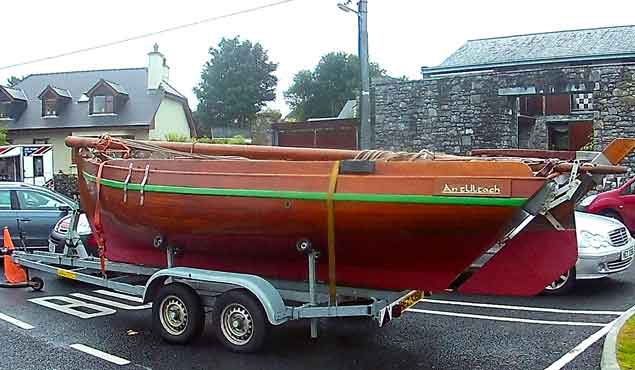 Is it a pucaun? Is it a gleotog? It depends on the size. And the rig. And other things…..This one had been road-trailed from the north. On a sunny day she might look orange, but she looked very brown on Sunday
Is it a pucaun? Is it a gleotog? It depends on the size. And the rig. And other things…..This one had been road-trailed from the north. On a sunny day she might look orange, but she looked very brown on Sunday
All we know is that every size was represented. There was even what looked like a pucaun road-trailed down from the north in a shade of brown through varnish which might look orange on a sunny day, but definitely looked brown in Sunday. And on the harbour in front of everyone was a traditional boat which seemed well on the way to becoming a yacht, for with her immaculate black topsides she sported a very stylish white boot-top at the forefoot to set off the blue anti-fouling.
The visual effect of a neat white boot-top, even a partial one, cannot be over-estimated – the great schooner Atlantic which was in Dun Laoghaire last week absolutely cried out for one, as she didn’t look her best with midnight blue topsides and dark grey anti-fouling with nothing in between.
But there in Kinvara was John Flaherty’s Naomh Cailin looking very well indeed with her white boot-top, and she was more than just good looks – she went out and won this gleotog mor class which is only just registering on our radar, and looked great doing it, with her Philip Watson sails settling in nicely as the breeze got a bit of life to it.
As for the really grown-up class, the bad mor division, that was won by the Tonai, skippered by Mairtin O’Brien. Yet again, the Kinvara gathering leaves us with a cascade of visions of unique boats - and unique people too. May it continue for ever.
 Kinvara’s Crinnui na mBad provides a cascade of visual memories to see everyone through to another year
Kinvara’s Crinnui na mBad provides a cascade of visual memories to see everyone through to another year



























